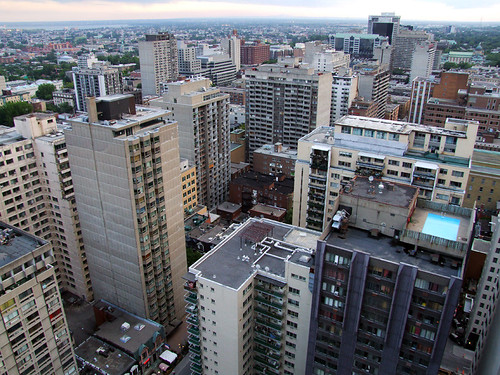The downtown west end is one of my favourite parts of Montreal. Densely-populated, teeming with life and resolutely multicultural, it feels unique because it departs so radically from the low-rise scale common in most neighbourhoods. In the blocks around de Maisonneuve, Lincoln and Tupper, between Guy and Atwater, there’s almost something Manhattanesque about the mix of old rowhouses and walkup apartment buildings with big postwar towers.
But, for all its vibrancy, pretty much anyone would be forced to admit that this part of Montreal is ugly. Hideous, even. The true extent of its laideur becomes evident when you climb to the top of one of its many highrises and gaze out upon a landscape of dull concrete erections.
Built in the 1960s and 70s as quickly and cheaply as possible, most of these buildings have no architectural grace. Unlike the postwar highrises in coastal cities like Vancouver, which are bright, airy and replete with quirky spage age details, most of the tower blocks in downtown Montreal rely excessively on poured concrete. Even worse, their sides are blank, which means that any view of the neighbourhood from afar is marred by a skyline of empty concrete walls.
So here’s an idea I’ve stolen from Tirana, the capital of Albania: let’s turn our boring concrete blocks into colourful, eye-catching monuments to Montreal’s creative spirit. Like Montreal, Tirana witnessed the construction of hundreds of concrete apartment buildings in the decades after World War II. (Unlike Montreal, they were driven by Communist fervour, not profit, but that’s another story.) Until recently, its civic palette consisted of multiple shades of drab. That was before Tirana elected an artist, Edi Rama, as its mayor. One of his first acts was to order thousands of gallons of paint.
The New Yorker described what happened in a 2005 article:
 Rama has been in office for nearly five years (he was elected in 2000, at the age of thirty-six, and reelected three years later), and the first thing he did was to order paint. He blasted the facades of Tirana’s gray Stalinist apartment blocks with color—riotous, Caribbean color—turning buildings into patchworks of blues, greens, oranges, purples, yellows, and reds, and the city itself into something close to a modern-masters sampler. (Art in America put a Tirana façade on its December cover; it looked like an abstract painting.)
Rama has been in office for nearly five years (he was elected in 2000, at the age of thirty-six, and reelected three years later), and the first thing he did was to order paint. He blasted the facades of Tirana’s gray Stalinist apartment blocks with color—riotous, Caribbean color—turning buildings into patchworks of blues, greens, oranges, purples, yellows, and reds, and the city itself into something close to a modern-masters sampler. (Art in America put a Tirana façade on its December cover; it looked like an abstract painting.)
It was an extravagant gesture, but Rama thinks in extravagant gestures. “The city was without organs,” he says, meaning that it was a dump, and that nothing in it functioned. (“Kandahar” is how he usually describes it.) “I thought, my colors will have to replace those organs. It was an intervention.”
If we had the will to do something similar in Montreal, I doubt it would be hard to accomplish. It would cost a couple of million dollars, sure, and it would involve negotiations with dozens of property owners, but it would be well worth the effort in tourist dollars, international press and a massive boost in civic pride. Why not?
First Montreal photo by Lyle Stewart; Tirana photos by David Dufresne and Rapsak




11 comments
I’ve thought about doing this for years. Actually, it’s funny that you mentioned Vancouver earlier on, because that city has its share of monstrous post-war apartment towers. Back in 2005, at the height of the Coal Harbour condo construction frenzy and just as construction began the convention centre expansion, a clever tower owner had two older cement towers painted black! Like Van der Rohe matte black. It looks brilliant and it certainly had the desired effect, which was to make his buildings stand out among the newer glass towers.
Over on coolopolis today, Kristian rails against high rises in Montreal, suggesting Montreal define itself nationally as the low-rise city.
A suggestion: the wide availability of photo-editing software lends itself to amateur manipulation. How about spacingmontreal.com hold a little contest: spacingmontreal provides a group (3-5) photos of the concrete blocks, and users submit color-edited schemes.
Nice idea. Who doesn’t want more colour in our grey winter environment, but I’m skeptical of implementation. You know what happens to paint on concrete in a winter climate? All you need to do is look at that exposed foundation on so many of our fine homes. It peels like crazy and needs repainting every few years. Tirana has a Mediterranean climate, not unlike Spain and California. Not quite the same as Montreal…makes me long for a holiday to warmer climes.
I lived in a city with color, for almost all my life: Mexico City. And yes, the solution when concrete started to look too old and grey, well, they painted it.
It does look nice for a couple of months, then it fades, again it seems dirty, grey *but a colorish grey* and also, after months or years, using the same colors makes the whole landscape BORING. And painting has to be done each 2 or 3 years, otherwise it peels off and looks even more awful. Changing colors is more expensive because you have to get rid of the earlier shades.
Unfortunately the 60 and 70 didn’t leave behind colorful or natural traces. We find these buildings boring, agressive in terms that they don’t blend with the whole picture, cold and even extravagant. I like better what was done in the 80 and 90 in Mexico. And well, the high rises built from 2000 to date, even though mainly shiny and all of glass, they have a tendency to “fit in”.
I can’t think of a solution to this. But I can assure you, it is definitely not painting.
*my humblest opinion*
Some photos I found around
http://farm1.static.flickr.com/100/288863063_5a8d7594b2.jpg?v=0
http://farm2.static.flickr.com/1026/873046219_952fb34af6.jpg?v=0
http://www.ada.ch/images/TorreMayorb_jpg.jpg
An example of the new stuff vs the old stuff
I think Montreal could have been a low-rise city before we tore most of the beautiful Victorian character down in the 50’s, 60’s and 70’s. I don’t agree that Montreal should be defined as a low rise city. At this point, we are stuck somehwere in between. Low rise is a lovely idea but in this day and age is the recipe for mediocrity for a few reasons which we are already seeing manifested:
we are not going to see the same kind of construction in terms of architecture, design, and quality as we once had. Orange brick and stucco is what is likely to be built. Vacant land in Montreal is worth more as a parking lot than a four storey building; rent levels are low land costs are high making it economically infeasible to build. Higher buildings not only have to capacity to add grandeur to the streetscape. I would much rather people be critical of architecture and quality of design and materials rather than just look at and rail against height.
Tamara, there are certainly options other than painting. Some sort of art project could be sponsored that would use the more visible blank walls on some of these buildings. If we have the technology to erect giant billboards for commercial use, we can certainly do the same for art.
Subtle additions of colour can do a lot to improve the appearance of a building, too. There’s a big concrete slab at the corner of Berri and Sherbrooke. Last year, the black siding on the central portion of its façade were replaced with red ones. The improvement is extraordinary.
Edward, it might be unfeasible to build rental low-rises, but at one intersection in my neighbourhood, a parking lot, a gas station and a car wash have all been replaced by low-rise condos in the last couple of years. From the perspective of in-fill densification, this is a positive development; from the perspective of affordable rental stock, not so much. On the point about the level of interest of the architecture of these buildings, you’re spot on.
Hi,
Sorry for being a bit late on this one. It’s been a bit of a crazy week.
In regards to Albania, I agree with Tamara. For the first couple of months, it probably did look quite nice, but by the time I got there, it didn’t really strike me as so beautiful. In the end, the paint fades and starts to chip, and the garbage and pollution start to be what sticks out.
At the time I was there (over 2 years ago), Tirana’s biggest problem was that it needed to pave its roads. The old concrete had completely broken apart, to the point where to walk on the road you sometimes had to balance on loose slabs of the stuff. And many housing projects had been started on a grand scale, but after the foundations and framework were laid, they were left to rot. Poor financial planning? Massive siphoning off of the funds by anyone and everyone, to the point where there wasn’t enough money to finish? Probably both. But it didn’t stop people from living in them. If they were lucky, they had roofs on their frames. But no walls to paint pretty colors :(
I agree with your suggestions Christopher.
I have lived in Montreal for the last 12 years, 7 of which I spent on Saint-Mathieu street. Of all the cities I have lived in and visited in my life, Montreal is by far the ugliest and the most backward and tasteless in its urbanism. Not a day goes by without me shaking my head at poor esthetic choices, dirty storefront, horrendous architecture or abominable public design. It also seems that in Montreal, no one has yet figured out that windows and facades can and should be cleaned once in a while, like in other cities around the world.
It’s hopeless.
This has been most interesting. I thought no one really cared or noticed the lack of color and tasteful design enough. Toronto too has grey, monstrous slabs of concrete that make me very unmotivated. I hope something innovative can be done taking into consideration the brutal climate.